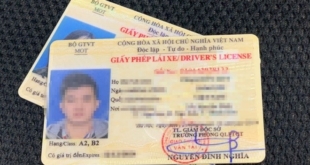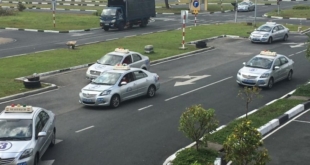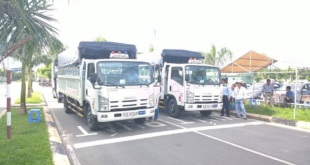Blind spots and dead spots are areas around the truck that the driver cannot see directly through the rearview mirror or with the naked eye. These are potential dangers for both truck drivers and other vehicles participating in traffic.
According to the US National Highway Traffic Safety Administration (NHTSA), truck blind spots are the cause of 10% of traffic accidents involving trucks. In Vietnam, according to statistics from the Ministry of Transport, in 2023 there will be 12.345 traffic accidents involving trucks, of which 3.456 cases are caused by blind spots.
The cause of blind spots and dead spots comes from the vehicle structure, the position of the rearview mirror and the driver's seating position. When there are vehicles moving in these areas, drivers cannot observe them, causing many potential dangers such as accidents, traffic jams, or even fraudsters taking advantage.
To overcome this problem, drivers need to adjust the rearview mirror properly, install support systems such as cameras, sensors, blind spot warnings, and at the same time hone driving skills such as carefully observing, checking check shoulders, use turn signals.
Besides, it is necessary to check the vehicle before departure, obey traffic laws, drive carefully, pay attention to the weather, etc. to ensure the safest traffic.
The article below, City Driving Training & Testing Center. HCM will synthesize all important information about blind spots and dead spots of trucks. Let's follow along.
1 What Are Blind Spots and Dead Spots?
Blind spots and dead spots are hidden dangers that always lurk on every truck journey:
- Blind spots (hidden corners) are areas around the vehicle that the driver cannot observe directly, whether using the rearview mirror or observing with the naked eye.
- Dead spots (dead corners) are areas that are beyond the view of both the rearview mirror and the naked eye.
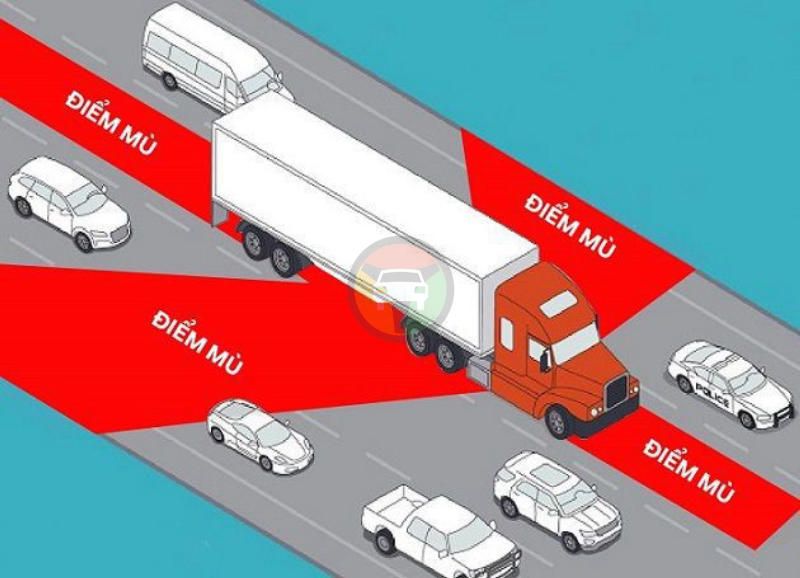
2 Why Are There Blind Spots and Dead Spots in Trucks?
Blind spots and dead spots of trucks are formed due to the bulky size of the vehicle, which limits visibility in some places, and the position of the rearview mirror cannot cover the entire rear and the driver's sitting position.
Besides, truck drivers have to process a large amount of information on the street, and continuously observing the entire space around the vehicle is not easy. This leads to the risk of missing hidden and dead corners.
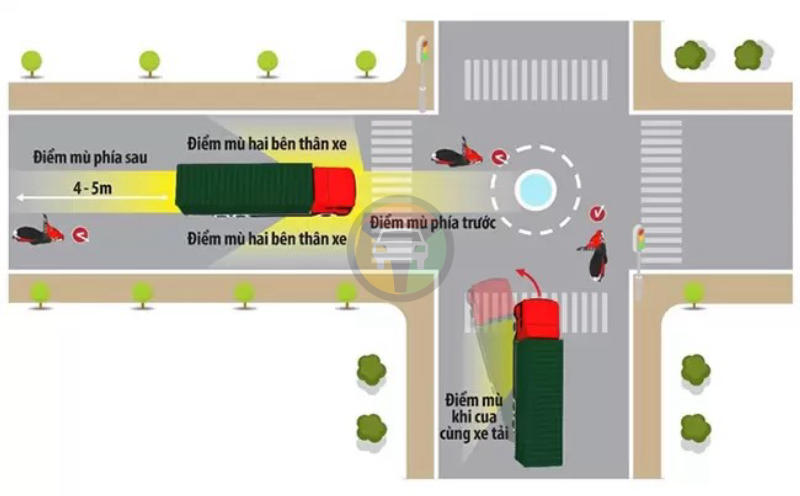
Specific causes of blind spots and dead spots:
- Vehicle structure: Parts such as A-pillar, B-pillar, rearview mirror, trunk... can obscure the driver's vision.
- Location of rearview mirror: The rearview mirror cannot cover the entire area around the vehicle.
- Driver's seating position: High or low seating position also affects the driver's vision.
3 What Dangers Do Blind Spots and Dead Spots Cause in Trucks?
Blind spots and dead spots of trucks can cause many hidden dangers such as limited visibility, easily causing accidents, traffic jams, and being taken advantage of by thieves.
According to FMCSA, blind spots are one of the leading factors in accidents involving trucks, contributing significantly to road casualties.

Dangers of blind spots and dead spots of trucks:
- Limited observation: Blind spots and dead spots on trucks limit the driver's ability to observe and recognize potential dangers. Without much experience and concentration when driving, it will be difficult for the driver to recognize dangerous situations when other vehicles approach.
- Easy to cause accidents: Blind spots and dead spots on trucks can prevent drivers from seeing small vehicles or pedestrians in hidden corners. This can lead to accidents, especially when the truck changes lanes or makes a U-turn.
- Traffic jam: When the driver cannot see surrounding vehicles, changing lanes, turning or reversing can be difficult, leading to traffic jams.
- Potential danger: Thieves can take advantage of the truck's blind spots and dead spots to steal property on the vehicle.
4 How to Fix Blind Spots and Dead Spots in Trucks?
To overcome blind spots and dead spots, drivers can: carefully adjust the rearview mirror, install assistance systems, hone driving skills, choose a car with a design to limit blind spots, and apply warning decals. Report and try to keep a safe distance from other vehicles...
According to the US National Highway Traffic Safety Administration (NHTSA), trucks should be equipped with standard blind spot warning systems, dash cameras and blind spot cameras to minimize dangers from truck blind spots.

Adjust the rearview mirror
Outside mirrors should be adjusted to eliminate blind spots as much as possible. The inside rearview mirror needs to be adjusted to cover the entire rear windshield.
Install support system
Car owners can install additional supporting technologies such as sensors, cameras and blind spot warning systems to minimize risks:
- Blind spot monitoring camera: Camera mounted on the rearview mirror or on both sides of the vehicle to display blind spot images on the screen in the cabin.
- Blind spot warning system: Use radar or sensors to detect vehicles in blind spots and warn the driver audibly or visually.
Increase driving skills
Truck drivers must be carefully trained on blind spots, dead spots and the skills to observe, use warning lights, and handle situations quickly:
- Observe carefully: Look in the rearview mirror and observe directly before changing lanes, turning or backing up.
- Shoulder check: Look over your shoulder to check your blind spot before changing lanes.
- Use turn signals: Turn on turn signals before changing lanes or turning to notify other vehicles.
Other measures
In addition to the above solutions, there are also a number of other measures to limit blind spots and dead spots such as:
- Choose a car with a design to limit blind spots: Some cars have large windshields, wide rearview mirrors or smaller windows to minimize blind spots.
- Stick warning decals: Stick blind spot warning decals on the car to remind pedestrians and surrounding vehicles.
- Keep a safe distance: Keep a safe distance from other vehicles to have time to react when necessary.
Pedestrians, cyclists and small vehicles should also note:
- Avoid driving in the truck's blind spot: Avoid moving too close to the truck, especially in the front, back and sides of the vehicle.
- Pay attention and observe: When moving near a truck, pay attention to the driver's gestures and signals.
- Eye contact: Make eye contact with the driver to make sure they see you.
5 What should you keep in mind when driving a truck?
To have a safe trip, truck drivers need to check the vehicle carefully before departure, have a clear route, stay alert, obey traffic laws, drive carefully, and pay attention to the weather. , use mobile phones safely, comply with load regulations and periodically maintain the vehicle.

Before driving:
- Check the car: Thoroughly check important parts such as brakes, tires, headlights, wipers, etc. to ensure safety.
- Plan your route: Determine in advance the route, travel time and stops. If you drive long distances, you need to have a careful plan to drive long distances safely. If you often travel long distances, you can refer to the article: "Long-distance car driving experience” that we shared previously.
- Full rest: Make sure to get enough sleep before driving to avoid drowsiness and loss of concentration.
When driving:
- Comply with traffic laws: Understanding and obeying traffic laws helps you travel at the right speed, pay attention to signs and markings and avoid traffic violations that will result in your driver's license being revoked (Refer to the article for more information: "Summary of violations that result in the driver's license being revoked".
- Keep a safe distance: Keep distance from other vehicles to have time to react when necessary.
- Observe carefully: Use the rearview mirror, inside rearview mirror, and direct observation to ensure there are no vehicles in the blind spot.
- Drive carefully: Avoid driving at high speed, swerving, swerving or changing lanes suddenly.
- Pay attention to the weather: Drive carefully in rain, fog or poor visibility. See details in the article "Experience driving a car in the rain” to ensure safety when traveling in bad weather, rain and wind.
- Use cell phones safely: Avoid using your phone while driving to focus on driving the car.
- Comply with load regulations: Do not exceed the permissible load to ensure safety for vehicles and traffic participants.
- Be careful when moving on steep terrain: Reduce speed and use low gear to ensure safety (If needed, please refer to the article: “Experience driving cars uphill. "
- Pay attention to other vehicles: Yield to pedestrians, cyclists and priority vehicles.
- Regularly maintain your vehicle: Regularly maintain your vehicle to ensure it is always in the best condition.
In particular, drivers need to bring identification documents and driving licenses according to regulations to avoid unnecessary penalties.
Above is detailed information about blind spots and dead spots of trucks. Hope to help you have useful experiences when participating in traffic. If you need to supplement your driver's license or study for a driver's license with B2, C, D,... contact the City Driver Training & Testing Center. HCM for the fastest advice!
 Driving test & training school in Ho Chi Minh City Training, teaching and driving test school in Ho Chi Minh City
Driving test & training school in Ho Chi Minh City Training, teaching and driving test school in Ho Chi Minh City

